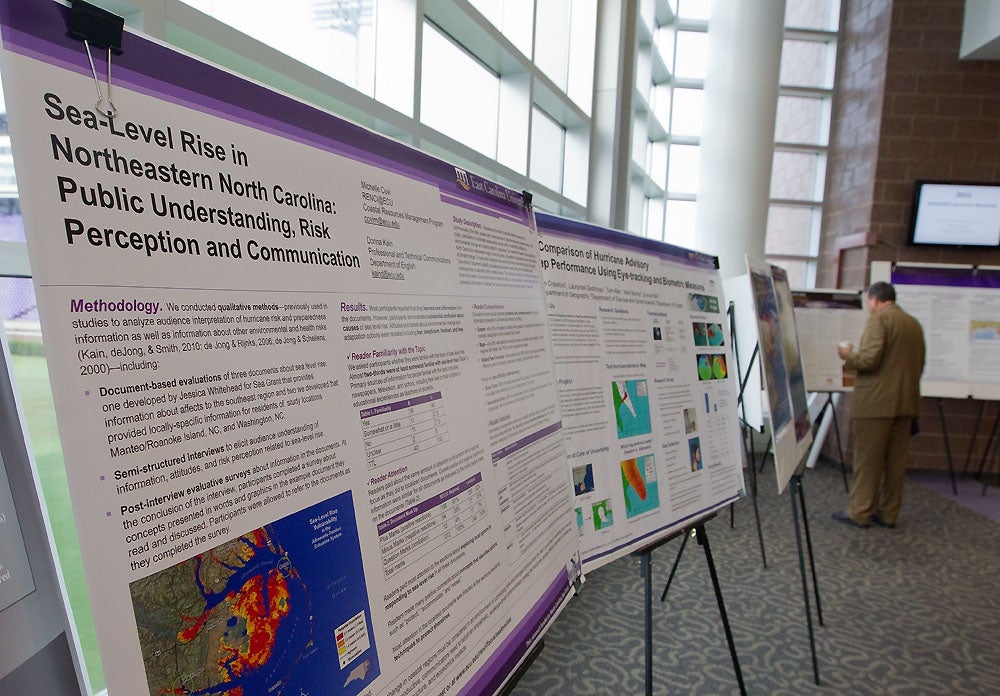LESSONS LEARNED
Workshop highlights best practices in emergency management
ECU is hosting the third annual North Carolina Hurricane Workshop today, bringing eastern North Carolina emergency managers and researchers together to discuss issues related to managing hurricane crises.
The director of the National Hurricane Center, Bill Read, will deliver the keynote address in the Murphy Center on campus.
“It’s a very good opportunity for researchers and emergency managers to come together and talk and to think about these issues,” said Donna Kain, director of outreach for RENCI at ECU and faculty affiliate of ECU’s Center for Natural Hazards Research. The workshop is hosted by North Carolina Division of Emergency Management, East Carolina University’s Center for Natural Hazards Research and the Renaissance Computing Institute’s Engagement Center at ECU. It is co-sponsored by North Carolina Sea Grant.

Bill Read, director of the National Hurricane Center, is the keynote speaker at the hurricane workshop at ECU May 23. (Photo by Cliff Hollis)
The conference will include interactive sessions with expert panels in social media and emergency communications, communications with maps and graphics, news media interactions with emergency management community and lessons learned from Hurricane Irene.
Hurricane Irene made landfall as a Category 1 hurricane, Aug 27, near Cape Hatteras, bringing winds that gusted up to 73 miles per hour. The storm lasted 12 hours and brought 12 inches of rain. Irene left the university with $1.5 million in damage, power outages and scattered debris, forcing a two-day closure.
ECU administrators worked throughout the storm to regain power to stay in contact with the community.
“Communication was probably our biggest problem in a number of ways,” said ECU Environmental Manager Tom Pohlman, who is in charge of disaster planning and preparedness.
One reason for the lack of communication during the storm was the power outage on campus. When the electricity went out, the cooling tower where university servers are housed switched off as well. When the power came back on, the cooling tower did not switch back on, so the room heated up to 120 degrees and servers went down. All IT ability was lost, including phone connection and the ability to send out alerts.
Pohlman said additional communication issues arose when students acted as reporters, posting videos of Greene Hall, where wind pried at the roof enough to break a storm drain pipe underneath and send water into the building. Students posted the video on YouTube and submitted it to local news stations, fueling rumors that the roof had collapsed.
“Rumor control became a big issue, and one of the lessons learned partially from this… is that we need to monitor the rumors and get out there in front of them,” he said.
Working alongside ECU News Services, Pohlman works hard before an emergency occurs so that the university can provide accurate information to other news services through online media while an emergency situation is underway. One significant new tool is the development of an ECU “light” home page for ecu.edu, said Mary Schulken, executive director of communication, public affairs and marketing. The “light” page will be activated in a sustained or urgent emergency, and converts the university’s home page to a one-stop source for constant information from public safety, ECU alerts, Facebook and Twitter.
“We’re also trying to create a virtual Emergency Operations Center, where we can post details so that ECU administrators and News Service personnel can get accurate information,” Pohlman said.
“Getting information out in a timely manner was one of the lessons learned, and one of the things we’re looking for.”
Another lesson from Irene involved damage assessments. Pohlman said ECU is still trying to get funds from the Federal Emergency Management Agency for reimbursement from that storm’s damage.
“We’re in the process of putting together a damage assessment form so that the information we collect will match what FEMA wants, and that will make our recovery and recouping of funds a lot easier and quicker,” he said.
As part of hurricane planning, Pohlman said pre-event meetings were held to coordinate preparations and provide updates. He said communication beforehand is crucial, as well as after, during cleanup.
As information technology has improved through the years, we depend on it more and more. “So when that fails, a lot of things don’t work quite the way they should,” he said.
“You can’t ever underestimate what a hurricane will do.”
“A lot of things have to be planned when you see one of these events coming,” he said. When an emergency such as Hurricane Irene takes place, Pohlman will apply lessons learned to the university’s hurricane planning and procedures.
